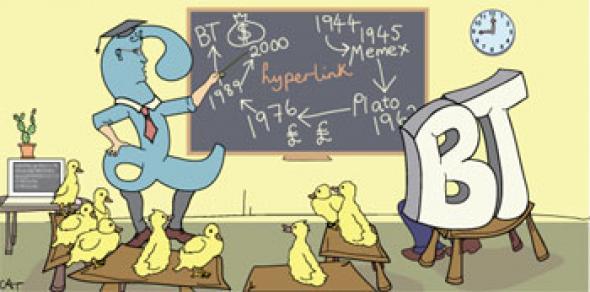Thanks for the Memories
Mike Holderness finds a reason to thank BT for their attempt to patent the hyperlink …
The best thing about British Telecom’s plan to enforce a patent on the concept of the hyperlink is that it’s made a lot more people aware of the history of the idea. With any luck, the low point of this process will be the way that geeks on slashdot.org, within hours of the news, degenerated from a collective attempt to remember the history into an argument about what nation defeated the Wehrmacht in 1944. In July 1945, as it happens, Vannevar Bush published his essay “As We May Think” in the Atlantic Monthly. There Bush, who suddenly had some free time from his job as science advisor to the Prez, notoriously proposed the Memex information machine.
The Memex is usually pictured as a crazy clockwork microfiche-shuffler. But on re-reading the essay you realise that he is obviously discussing, in coded fashion, technologies which were secret at the time. He proposes the Memex as a worthy successor to the first ever example of mass science, the Manhattan Project which built the atomic bombs dropped on Hiroshima and Nagasaki the following month.
Bush was also involved in the development of digital computers for code-breaking: he knew about Alan Turing’s work that was Officially Secret until the 70s. The Memex comes complete with remote radio access and direct neural input. On the face of this intertextual reading, it is a digital computer and as ‘prior art’ wipes out BT’s patent and several others beside.
Then, of course, there’s Ted Nelson’s brilliant piece of vapourware, Xanadu (Mute 17). You can find a detailed description of his überhyperlink concept in the Proceedings of the Association for Computing Machinery, 1965. Anyway, by 1962 the University of Illinois at Urbana-Champaign had started building its PLATO computer-assisted instruction system, with hyperlinks. In 1976 Post Office engineers working on the Prestel viewdata system filed their US patent for an “information handling system and terminal apparatus therefore”. It was granted in 1989, so it runs until 2006. All its European siblings have expired. So in June BT, as successor to Post Office Telephones and through patent advisors Cypher plc, wrote to ISPs in the USA suggesting they might like to pay royalties on hyperlinks.
US patent 4,873,662 describes a system for transmitting information over modems in blocks – anyone who’s written I/O using Algol 60’s Put() and Get() will understand. Blocks came in pairs. One defined the Teletext-style page the Prestel user saw. A second stayed hidden, defining the blocks to be fetched by hitting function keys, or charges for them, or other stuff. That’s a bit like a hyperlink. We can think of a web technology which it much more closely resembles, but you’ll have to pay us a lot of money to tell...
Mike Holderness <mikeh AT metamute.com>
“As We May Think”, http://www.isg.sfu.ca/~duchier/misc/vbush/
Mute Books Orders
For Mute Books distribution contact Anagram Books
contact@anagrambooks.com
For online purchases visit anagrambooks.com








